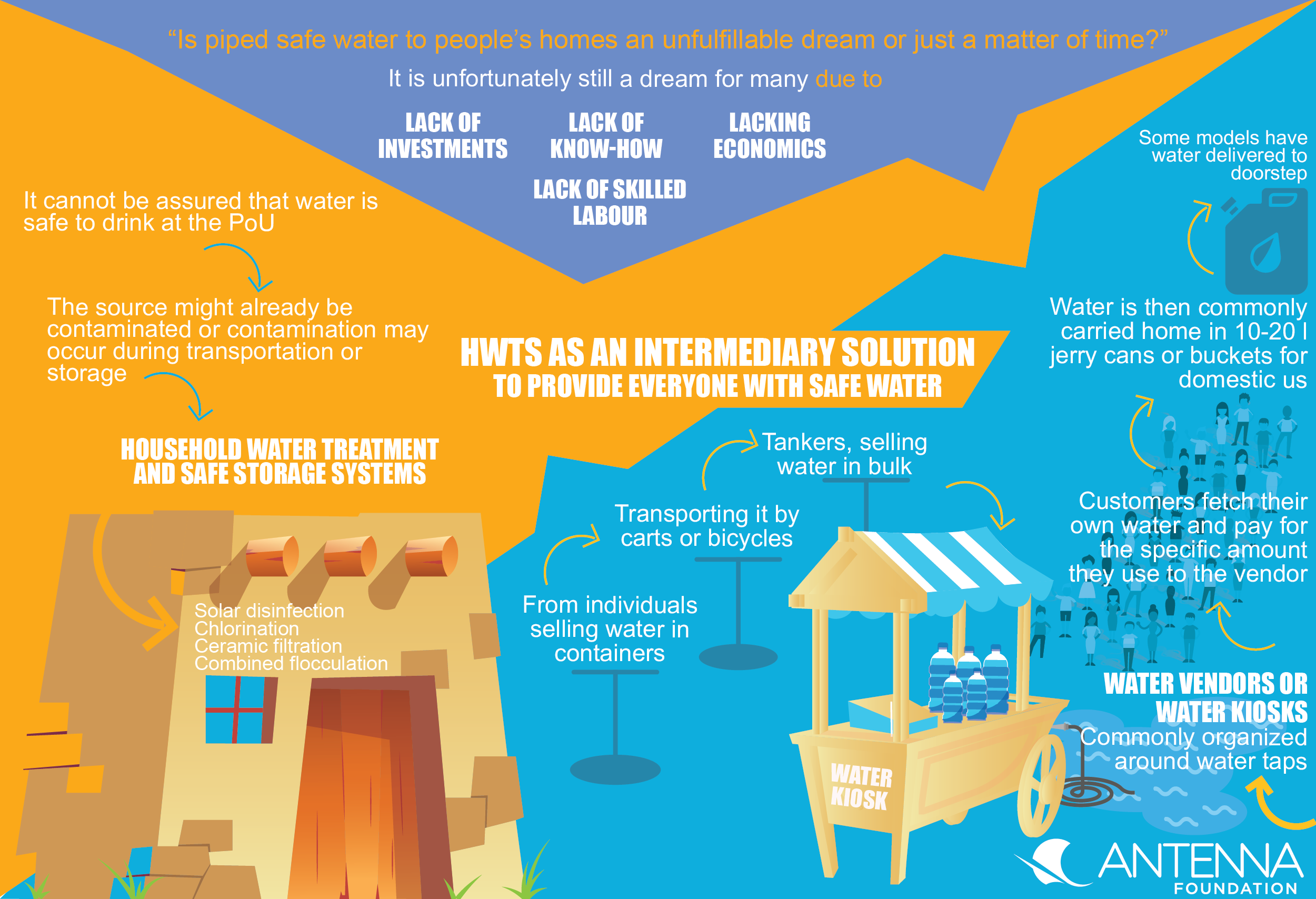Executive Summary

This background factsheet allows the reader to understand in what situations HWTS and water kiosks are long-term, productive and efficient safe water solutions.
HWTS as an Intermediary Solution to provide Everyone with Safe Water
Is piped safe water to people’s homes an unfulfillable dream or just a matter of time? Point of use water treatment options can play a crucial intermediary role while waiting for safe piped water. The subsequent text provides the reader with background information why and in what context HWTS and water kiosk models can be the solution for providing people with safe water. The second part of the text provides information on different HWTS technologies for choosing the most adequate one, as it is important to have a clear picture on what different technologies and solutions are potentially available. This will facilitate the decision-making process and choosing the most adequate solution for the respective area of intervention of a safe water enterprise.
Having piped water systems that deliver safe drinking water directly to people’s homes is unfortunately still a dream for many. The majority of people in the world are not privileged to benefitting from such centralised water provision. Reasons are various; such as lack of investments, lack of know-how and skilled labour, or lacking economics among others. But is it possible to achieve the ambitious goal of providing safe water for everybody or will it just remain a dream? The construction of decent water and sewage infrastructure is expensive, time-consuming and not possible to achieve within a short period of time (UNICEF 2009). By adding new innovative measures to the established mainstream solution of piped water it could be possible to reach everyone with safe water. There are different models in place that have proven to be economically and practically feasible: Point of Use (PoU) water treatment options, among them: water kiosks and water home delivery or water treatment at the household level with household water treatment solutions (HWTS).
Water vendors or water kiosks
Water vendors or water kiosks are common in many parts of the world, specifically where water scarcity or a lack of infrastructure prevails and the access to drinking water is limited. There are several forms of vending water, which range from individuals selling water in containers, transporting it by carts or bicycles, to tankers, selling water in bulk or water kiosks. Water kiosks are commonly organized around water taps, where customers fetch their own water and pay for the specific amount they use to the vendor. The water is then commonly carried home in 10-20 l jerry cans or buckets for domestic use. More convenient models are combined with a service provision, where water is delivered to the doorstep. Water entrepreneurs fill jerry cans with water and deliver it to their customers’ home, which is very convenient and time saving for customers. Please find more detailed information on water vendors / water kiosks or visit Spring Health.
Subscribe here to the new Sanitation and Water Entrepreneurship Pact (SWEP) newsletter. SWEP is a network of organizations joining hands to help entrepreneurs design and develop lasting water and sanitation businesses.
Household Water Treatment and Safe Storage Systems
Although people do have access to a so-called improved water sources with these deliveries or fetching options, it cannot be assured that water is safe to drink at the point of use (which is also the case with piped water). The source might already be contaminated or contamination may occur during transportation or storage. In these cases there are household water treatment and safe storage solutions, that allow water treatment at home in form of filters, chemicals and other technologies (UV, RO…) to be very useful:
HWTS are solutions designed for underserved markets that have no critical mass for economies of scale and people who do not have the political or economic capital to demand that from their local authorities. Due to the high initial infrastructure cost of a water scheme, the World Bank (2010) states, that it needs a certain threshold of people to be served in an area (depending on the context) to make a piped water scheme viable. Point-of-use water treatment addresses only water quality, offering potential health gains but few other benefits that are associated with piped-in water supplies (e.g. not having to spend time fetching water) (CLASEN 2009). However, when there is enough water in place, just not yet safe to drink, a variety of practical cases have shown that HWTS solutions can be an effective interim measure assuring access to safe drinking water while waiting for the long-term goal of reliable piped-water systems (CLASEN & MINTZ, 2004; MURCOTT, 2006; CLASEN, 2009; CLASEN, 2015; BROWN ET AL., 2013; WHO, 2016).
A compelling argument for HWTS interventions is also the low cost of implementing PoU treatment options:
| HWTS | Costs p. person per year [in USD] |
| Solar disinfection | 0.63 |
| 0.66 | |
| Ceramic filtration | 3.03 |
| Combined flocculation / disinfection | 4.95 |
The combination of low cost and high effectiveness renders household-based chlorination, the most cost effective of water quality interventions to prevent diarrhoea. When health cost savings are included in the analysis, implementing costs of HWTS interventions actually result in net savings of the public sector too (CLASEN 2009).
Technologies & Programmes
Read more on technologies for purification and HWTS. In order to identify the most suitable solution for your respective context, the World Health Organization (WHO) developed a toolkit for monitoring and evaluating household water treatment and safe storage programs as well as a publication on quantitative microbial risk assessment that will help you identify a feasible solution for your area of intervention. For an overall introduction to HWTS please follow the MOOC from EAWAG on coursera. A feasibility study will not only provide you with insights on technology but also on building a market-based approach for the technology of your choice.
Safe water for all: harnessing the private sector to reach the underserved
The International Network to Promote Household Water Treatment and Safe Storage
This PDF presentation presents what household water treatment and safe storage (HWTS) can contribute to reaching the millennium development goal. It also presents a network to promote household water treatment and safe storage (the “Network”), which was established in 2000 by the WHO.
WHO (2007): The International Network to Promote Household Water Treatment and Safe Storage. (= Combating Waterborne Disease at the Household Level (PDF Presentation) ). Geneva: World Health Organization (WHO) URL [Accessed: 26.02.2010]Cost-effectiveness analysis of water quality interventions for preventing diarrhoeal disease in developing countries
Scaling Up Household Water Treatment Among Low-Income Populations
This report examines the evidence to date regarding the scalability of HWTS. It seeks to consolidate existing knowledge and experience and distil the lessons learnt. Its primary aims are to 1) review the development and evolution of leading household water treatment technologies in their efforts to achieve scale, 2) identify the main constraints that they have encountered and 3) recommend ways forward.
CLASEN, T.D. (2009): Scaling Up Household Water Treatment Among Low-Income Populations. (PhD Thesis). Geneva: World Health Organization (WHO) URL [Accessed: 09.04.2010]

